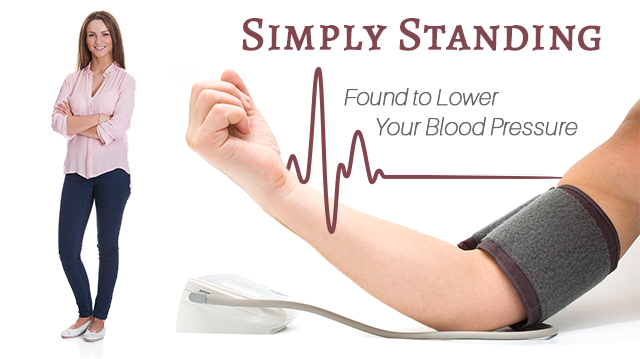
There are a number of ways to lower your blood pressure. Using medication, nutritional supplements, weight management and exercise have all been researched and reviewed extensively to fight hypertension. According to the American Diabetes Association, one in three Americans have high blood pressure, and this condition may lead to other chronic diseases like heart disease and diabetes.
Daily exercise including walking, cycling, running, and weight training have all been widely recommended by doctors for reducing high blood pressure. But what about lowering your blood pressure through the simple act of standing? Could this simple alternative be an effective approach to keeping you healthy and alive?
Dr. Glenn Gaesser, director of the Healthy Lifestyles Research Center at Arizona State University is an exercise aficionado, and he has found standing to be an effective blood pressure reducer. “Even standing might work,” said Dr. Gaesser in an interview with The New York Times.
Physical activity, even simply standing, immediately improves blood flow. Hypertension research conducted by Dr. Gaesser and colleagues at Arizona State University was recently published in Medicine and Science in Sports and Exercise (2015). The study found, “Compared to sitting, accumulating 2.5 h of light-intensity physical activity or standing during an 8-h workday may reduce ABP during and after work hours.”
The 2015 study involved nine obese or overweight adults as they completed four tasks (walking, cycling, standing, sitting) during four separate eight-hour workdays. The experiment’s control day, when the participants only sat, yielded the worst blood pressure readings. As predicted, the cycling and walking days proved the most beneficial. However, standing for 10 minutes every hour during an eight-hour workday had excellent results as well.
Who would have thought that such an easy alternative to low-intensity exercise would be so effective for lowering high blood pressure? It appears that just moving around the office for a bit might keep you alive longer. “Exercise intensity does not appear to play any significant role,” Dr. Gaesser commented.
 If you want to live a long, healthy and happy life, it is vital to keep your blood pressure well within the 120/80 range. Getting up and out for 30 minutes a day can lower your blood pressure by four to nine millimeters of mercury (mmHg), according to the Mayo Clinic’s guidelines for decreasing hypertension. If you don’t have the time to fit in 30 minutes of exercise, an excellent plan is to get away from your desk every hour or so for a standing stretch and 10-minute stroll around the office.
If you want to live a long, healthy and happy life, it is vital to keep your blood pressure well within the 120/80 range. Getting up and out for 30 minutes a day can lower your blood pressure by four to nine millimeters of mercury (mmHg), according to the Mayo Clinic’s guidelines for decreasing hypertension. If you don’t have the time to fit in 30 minutes of exercise, an excellent plan is to get away from your desk every hour or so for a standing stretch and 10-minute stroll around the office.
Getting regular exercise is an important factor in maintaining healthy blood pressure. However, there are other factors that can contribute to lowering your blood pressure. Watching your calorie intake to manage your weight, eating nutrient-rich foods like asparagus, lowering your sodium intake, avoiding alcohol, and quitting smoking should all be at the top of your list.
Changing your diet is one of the most important steps in decreasing your blood pressure. One commonly prescribed blood pressure medicine contains an angiotensin-converting enzyme (ACE), but there are severe adverse effects associated with the medication’s use. Luckily, nature often provides a safe and healthy alternative. Very recent research published in the Journal of Natural Products (2015) found that asparagus contains ACE naturally. There is always an alternative!
Simple lifestyle changes, like getting up to walk around every hour and eating more fruits and vegetables, can be effective in decreasing your blood pressure and improving your long-term health. How do you maintain healthy blood pressure?
—Stephen Seifert
Stephen Seifert is a writer, professor, adventurer and a health & fitness guru. His flair for travel and outdoor adventure allows him to enjoy culture and traditions different than his own. A healthy diet, routine fitness and constant mental development is the cornerstone to Stephen’s life.
Sources:
http://www.diabetes.org/are-you-at-risk/lower-your-risk/activity.html
http://www.ncbi.nlm.nih.gov/pubmed/26285021
http://pubs.acs.org/doi/abs/10.1021/acs.jnatprod.5b00092

